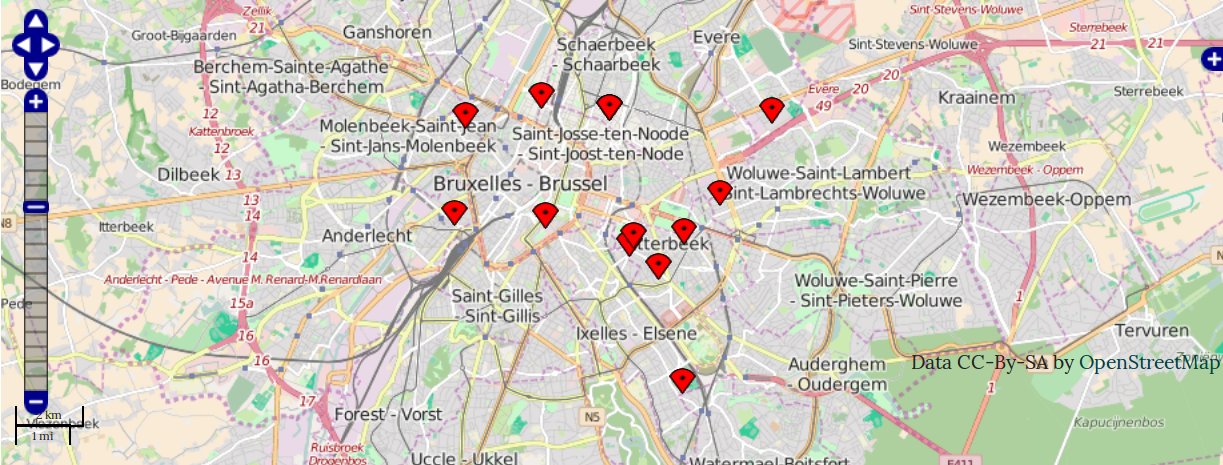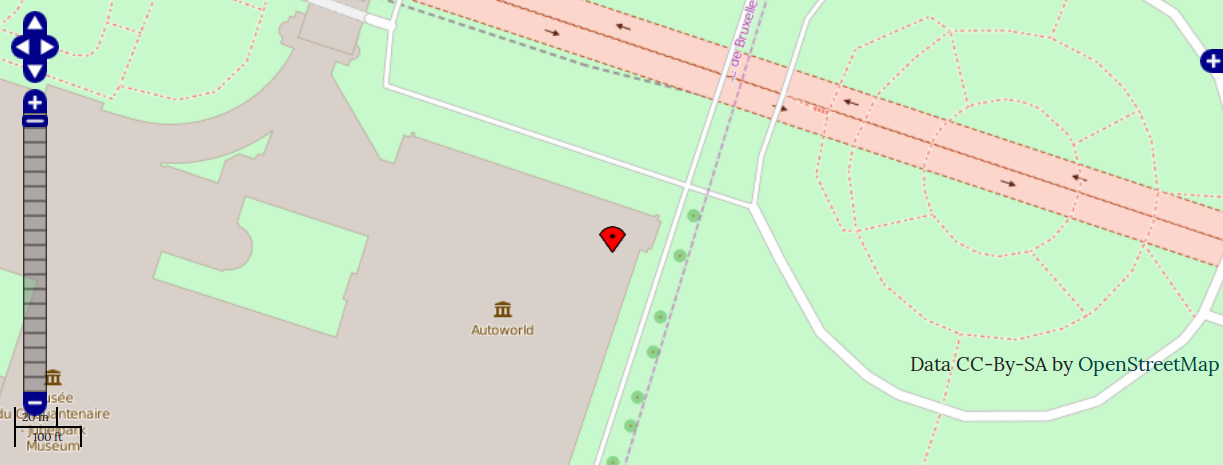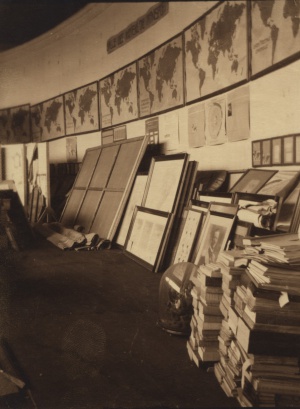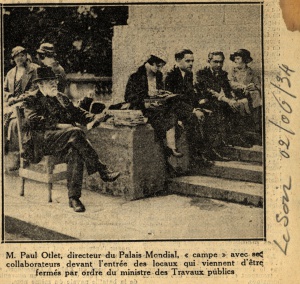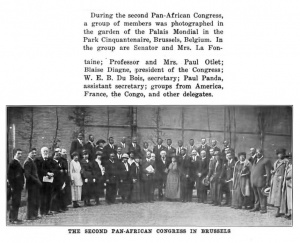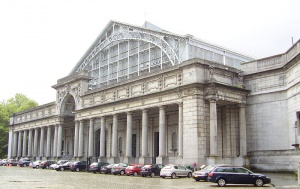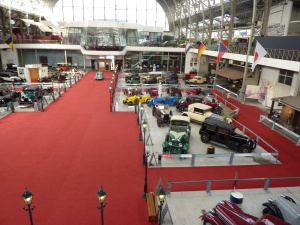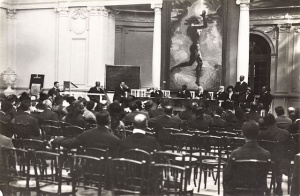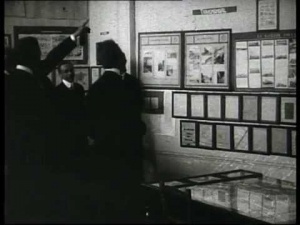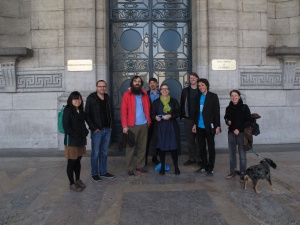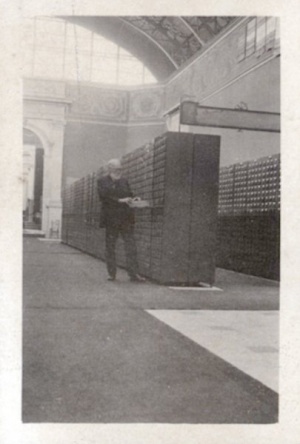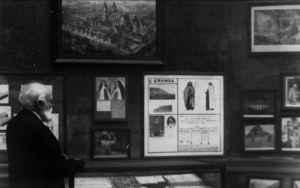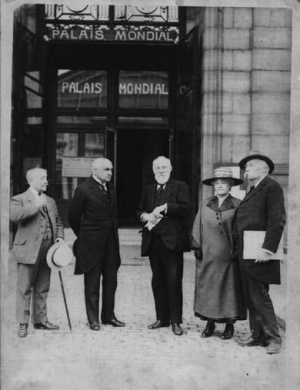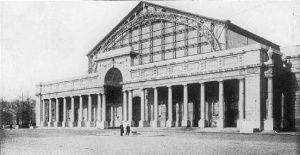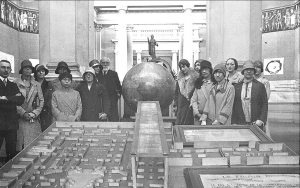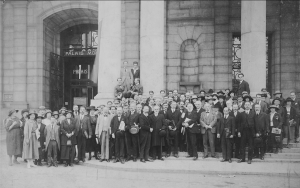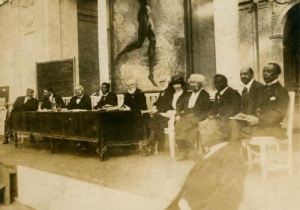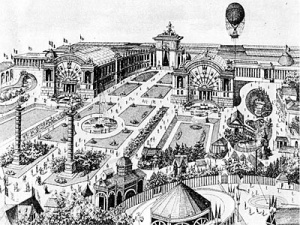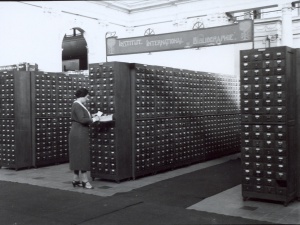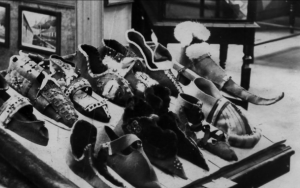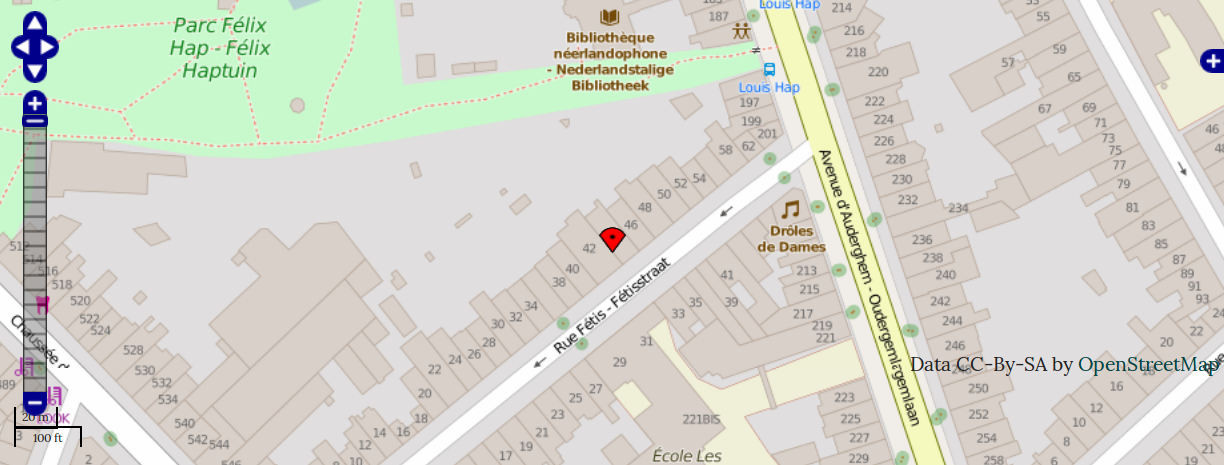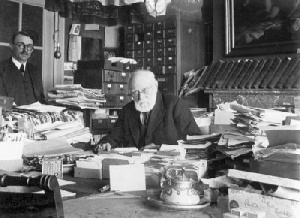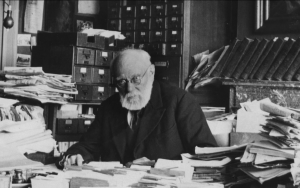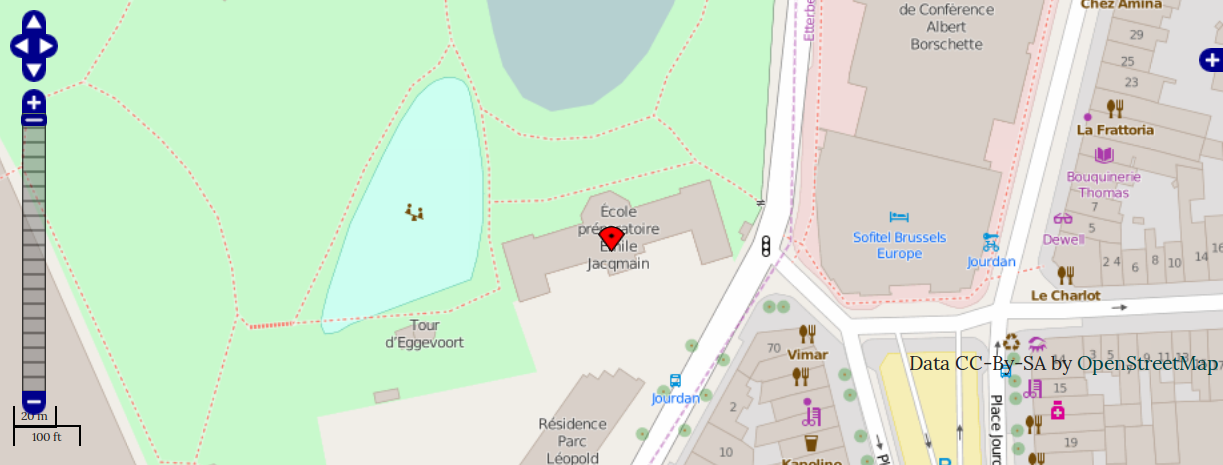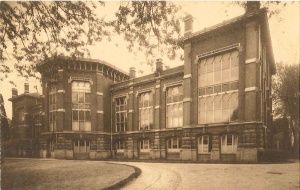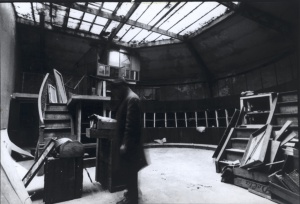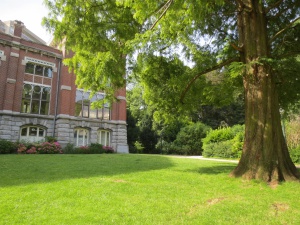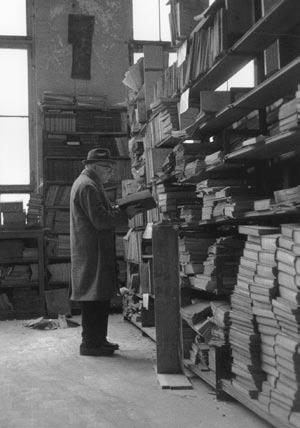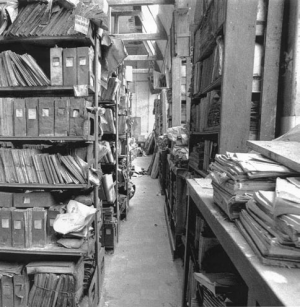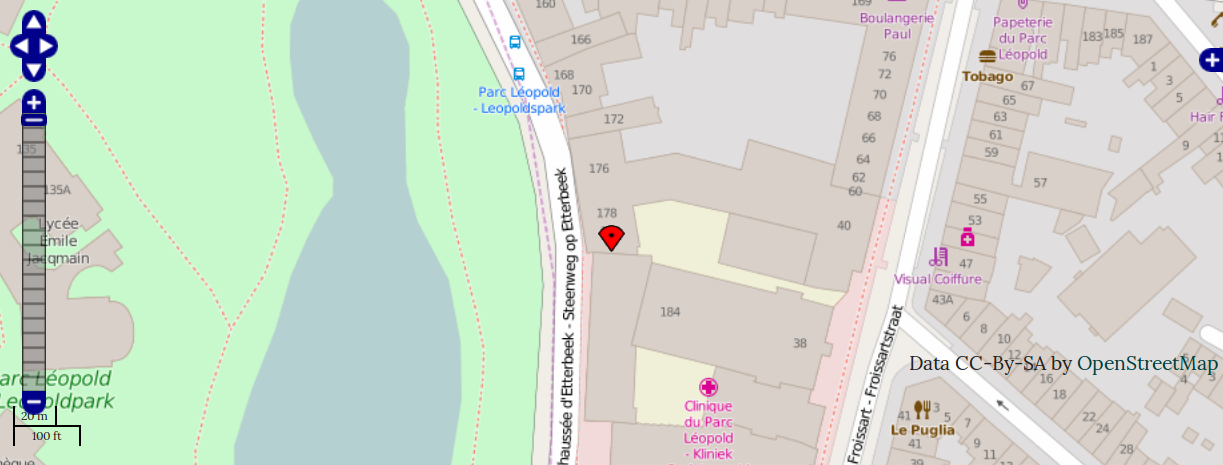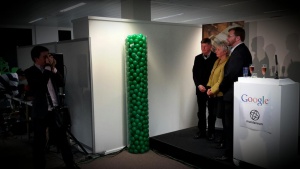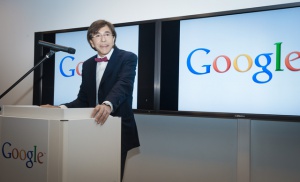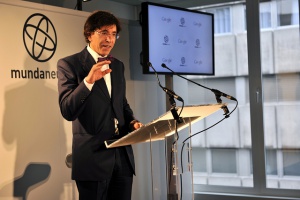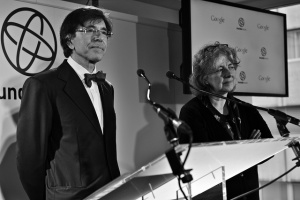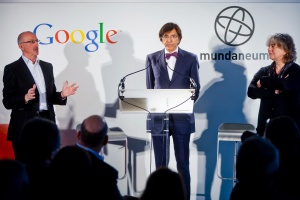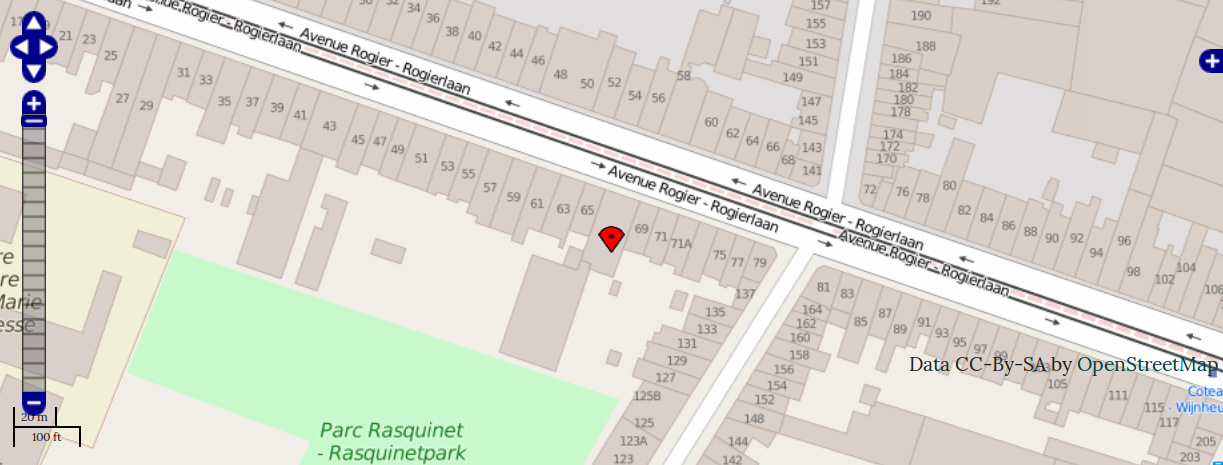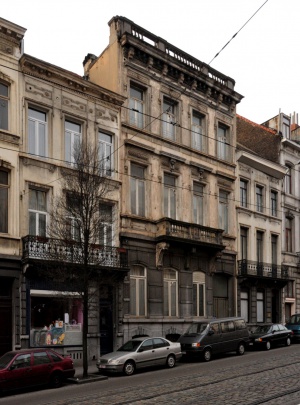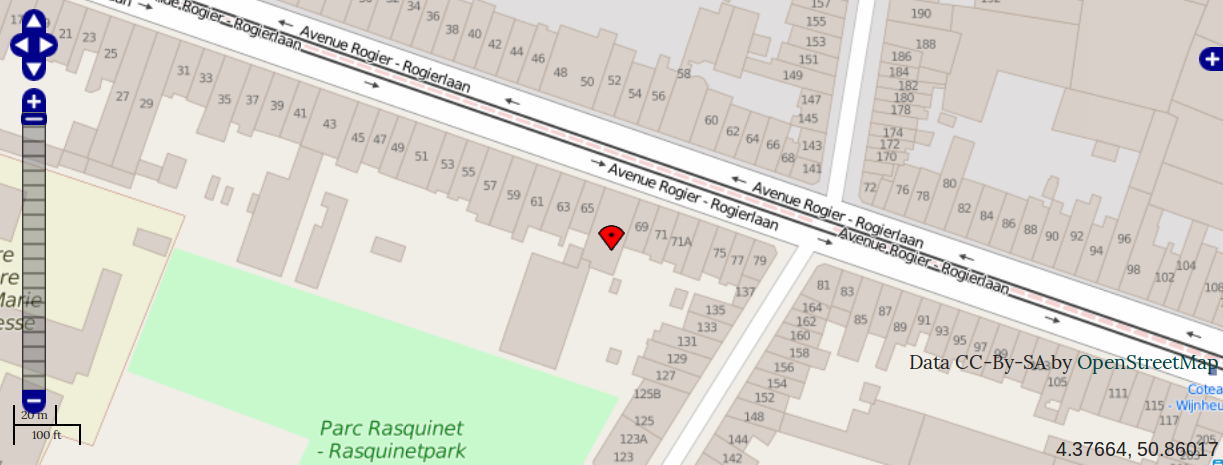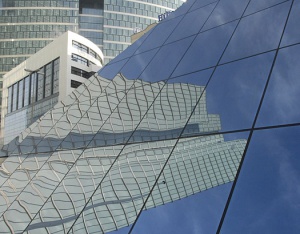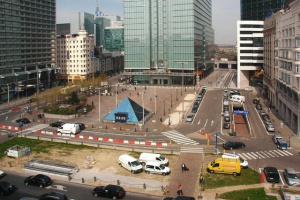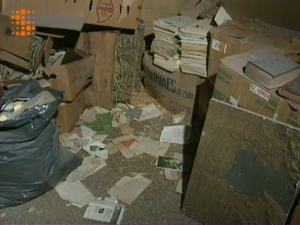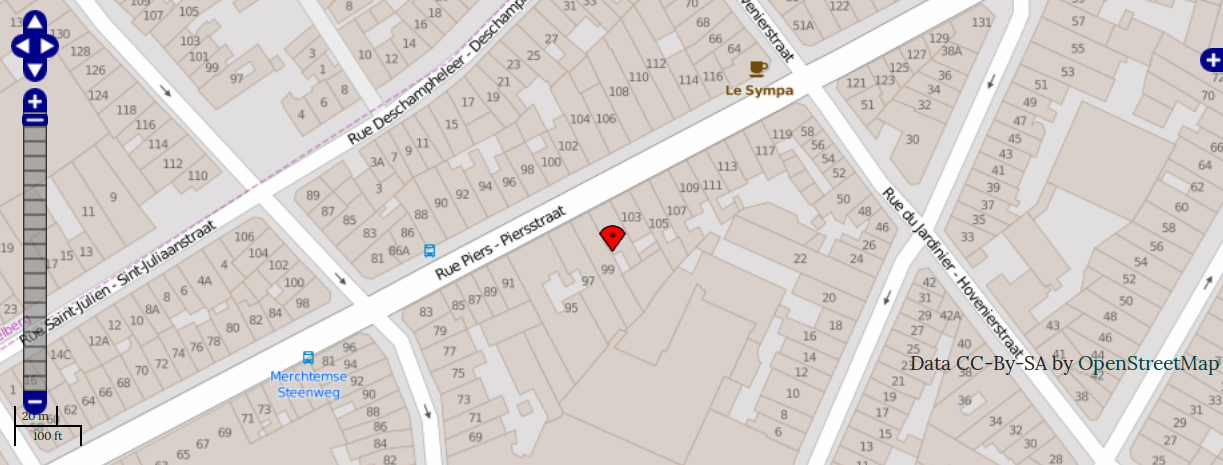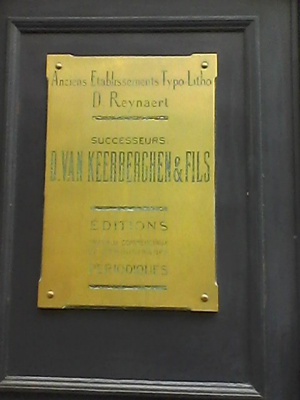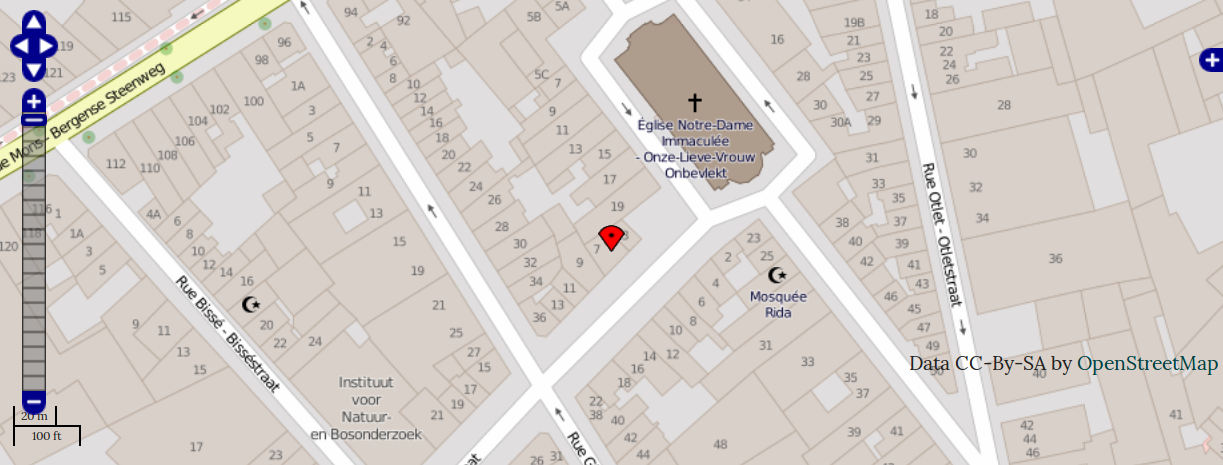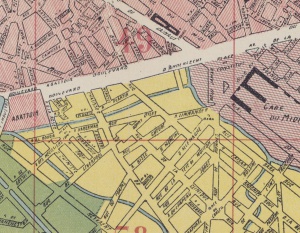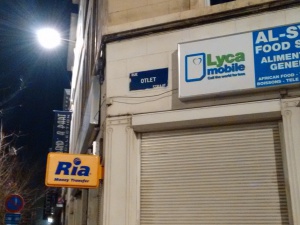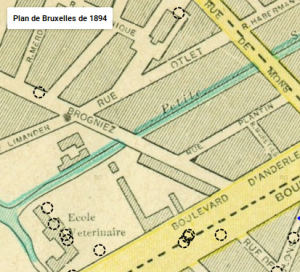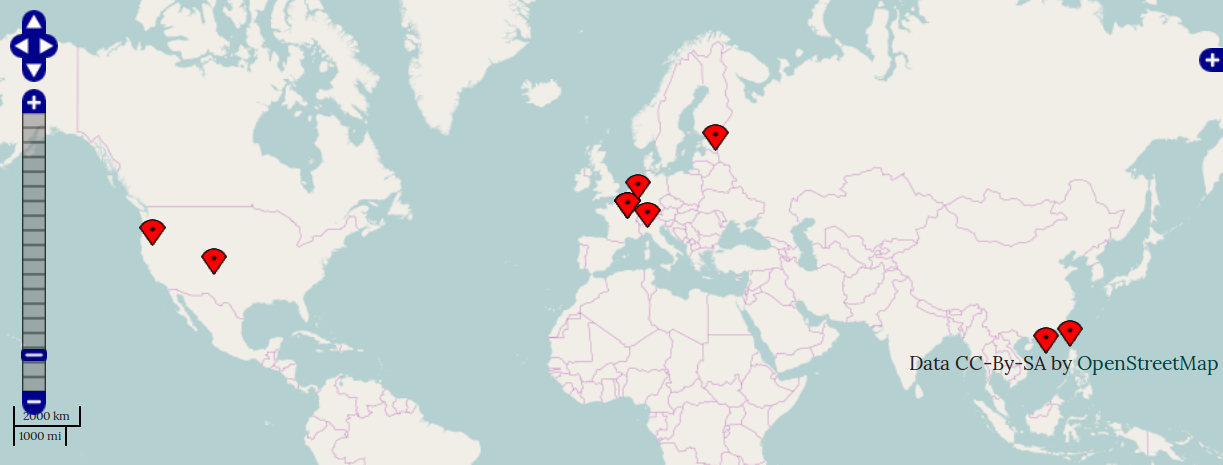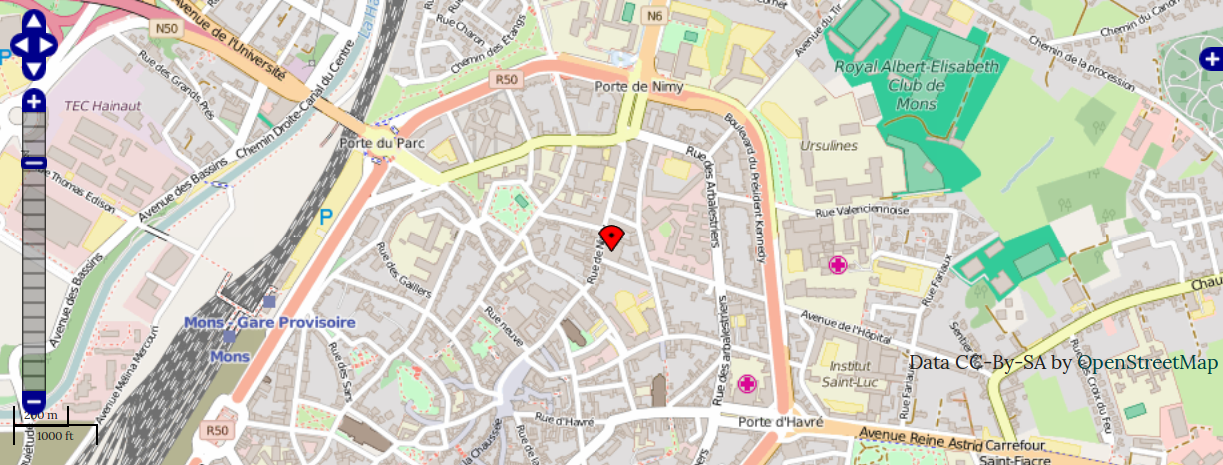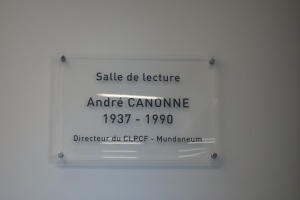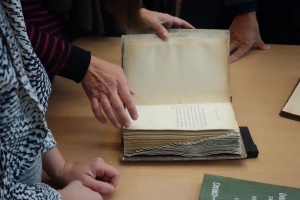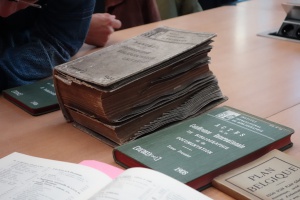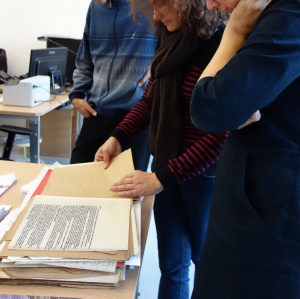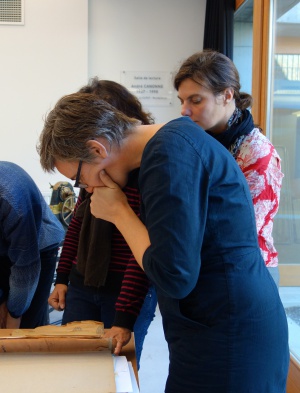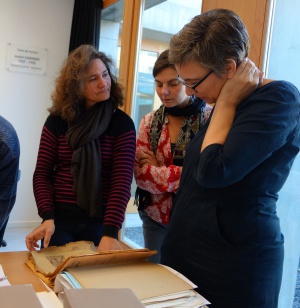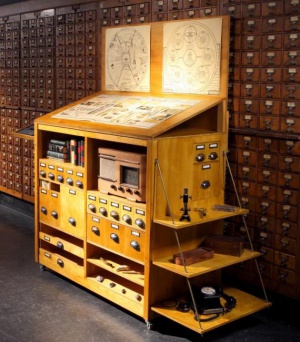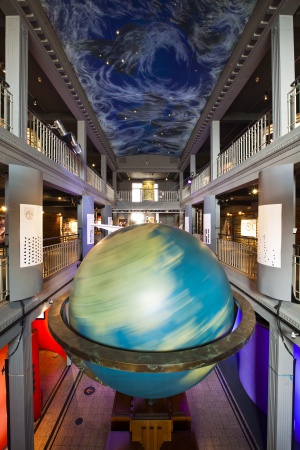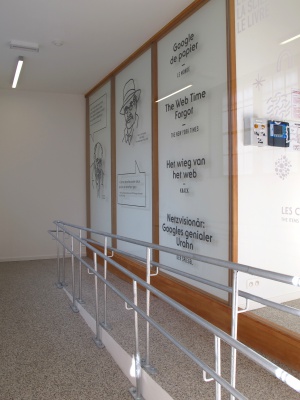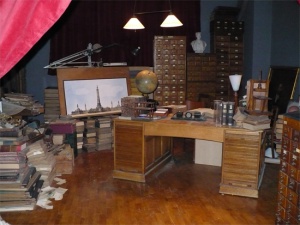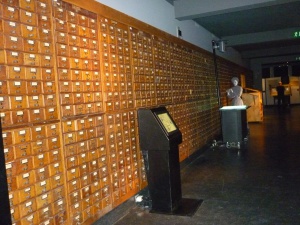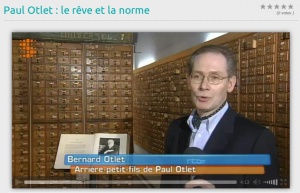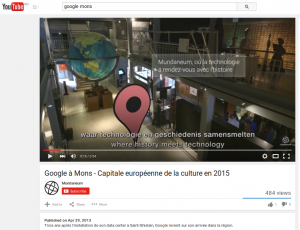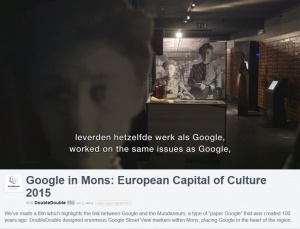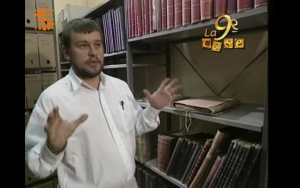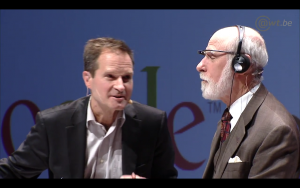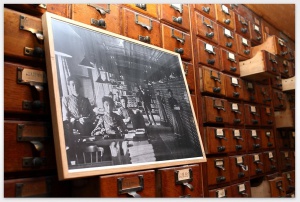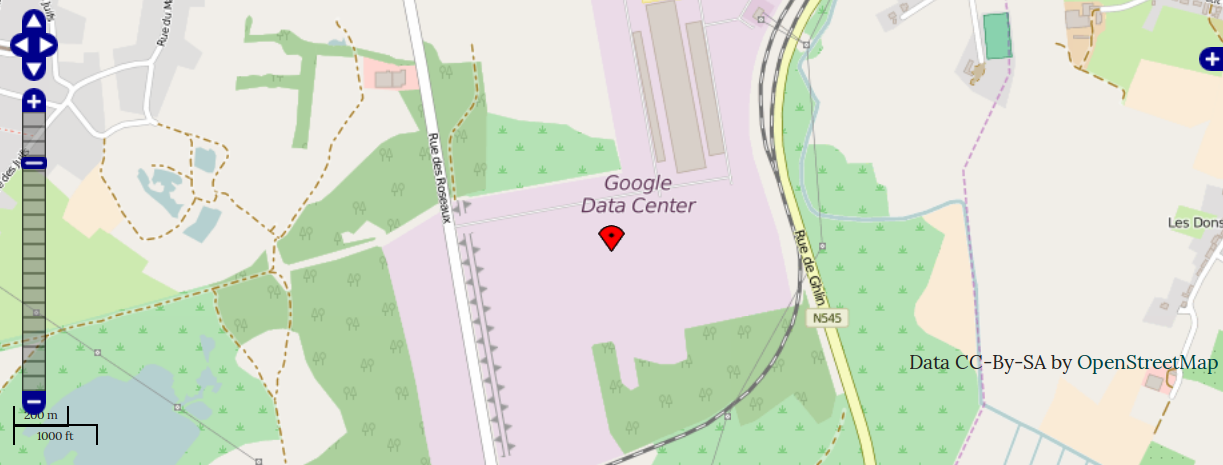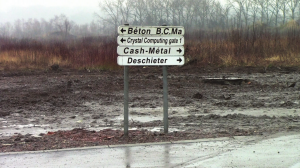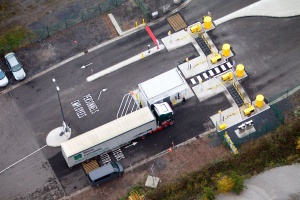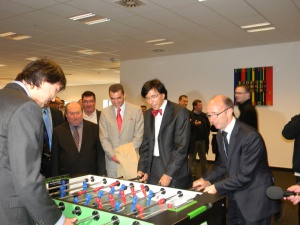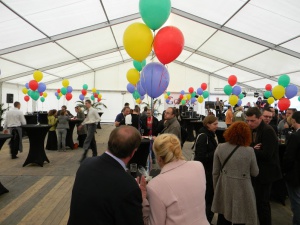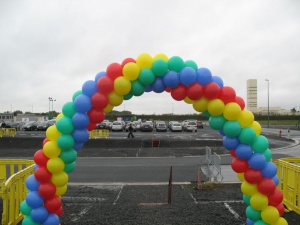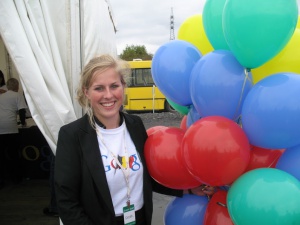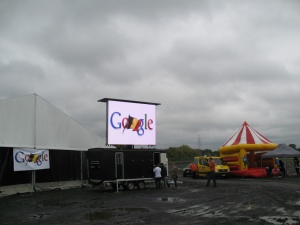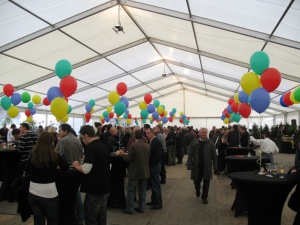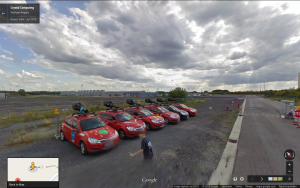Difference between revisions of "The Itinerant Archive (print)"
From Mondothèque
| Line 5: | Line 5: | ||
Its tragic demise was unfortunately equally at home in Brussels. Already in Otlet's lifetime, the project fell prey to the dis-interest of its former patrons, not surprising after World War I had shaken their confidence in the beneficial outcomes of a global knowledge infrastructure. A complex entanglement of dis-interested management and provincial politics sent the numerous boxes and folders on a long trajectory through Brussels, until they finally slipped out of the city. It is telling that the Capital of Europe has been unable to hold on to its pertinent past. | Its tragic demise was unfortunately equally at home in Brussels. Already in Otlet's lifetime, the project fell prey to the dis-interest of its former patrons, not surprising after World War I had shaken their confidence in the beneficial outcomes of a global knowledge infrastructure. A complex entanglement of dis-interested management and provincial politics sent the numerous boxes and folders on a long trajectory through Brussels, until they finally slipped out of the city. It is telling that the Capital of Europe has been unable to hold on to its pertinent past. | ||
| − | This tour is a kind of itinerant monument to the Mundaneum in [[Brussels]]. It takes you along the many temporary locations of the archives, guided by the words of care-takers, reporters and biographers that have crossed it's path. Following the increasingly dispersed and dwindling collection through the city and centuries, you won't come across any material trace of its passage | + | This tour is a kind of itinerant monument to the Mundaneum in [[Brussels]]. It takes you along the many temporary locations of the archives, guided by the words of care-takers, reporters and biographers that have crossed it's path. Following the increasingly dispersed and dwindling collection through the city and centuries, you won't come across any material trace of its passage. You might discover many unknown corners of Brussels though.</div> |
[[file:Brussels.jpg]] | [[file:Brussels.jpg]] | ||
| Line 23: | Line 23: | ||
<div class="inter">In [[date::1919]], significantly delayed by World War I, the ''Musée international'' finally opened. The project had been conceptualised by Paul Otlet and Henri Lafontaine already ten years earlier and was meant to be a mix between a documentation center, conference venue and educational display. It occupied the left wing of the magnificent buildings erected in the Parc Cinquantenaire for the ''Grand Concours International des Sciences et de l'industrie''.</div> | <div class="inter">In [[date::1919]], significantly delayed by World War I, the ''Musée international'' finally opened. The project had been conceptualised by Paul Otlet and Henri Lafontaine already ten years earlier and was meant to be a mix between a documentation center, conference venue and educational display. It occupied the left wing of the magnificent buildings erected in the Parc Cinquantenaire for the ''Grand Concours International des Sciences et de l'industrie''.</div> | ||
| − | <div class="inter">{{RT|mirror}}<section begin=mirror />Museology merged with the International Institute of Bibliography (IIB) which had its offices in the same building. The ever-expanding index card catalog had already been | + | <div class="inter">{{RT|mirror}}<section begin=mirror />Museology merged with the International Institute of Bibliography (IIB) which had its offices in the same building. The ever-expanding index card catalog had already been accessible to the public since [[date::1914]]. The project would be later known as the ''World Palace'' or ''[[Mundaneum]]''. Here, Paul Otlet and Henri La Fontaine started to work on their ''Encyclopaedia Universalis Mundaneum'', an illustrated encyclopaedia in the form of a mobile exhibition.<section end=mirror /></div> |
<div class="guide">Walk under the colonnade to your right, and you will recognise the former entrance of ''Le Palais Mondial''.</div> | <div class="guide">Walk under the colonnade to your right, and you will recognise the former entrance of ''Le Palais Mondial''.</div> | ||
| Line 47: | Line 47: | ||
</div> | </div> | ||
| − | <div class="guide">Walk under the Arc de Triumph and exit the Jubelfeestpark on your left. On Avenue des Nerviens turn left into Sint Geertruidestraat. Turn left onto | + | <div class="guide">Walk under the Arc de Triumph and exit the Jubelfeestpark on your left. On Avenue des Nerviens turn left into Sint Geertruidestraat. Turn left onto Kolonel Van Gelestraat and right onto Rue Louis Hap. Turn left onto Oudergemselaan and right onto [[Rue Fetis 44]].</div> |
| − | <div class="inter">In [[date::1934]], the ministry of public works decided to close the [[Mundaneum]] in order to make place for | + | <div class="inter">In [[date::1934]], the ministry of public works decided to close the [[Mundaneum]] in order to make place for an extension of the [http://www.kmkg-mrah.be/cinquantenaire-museum Royal Museum of Art and History]. An outraged Otlet posted in front of the closed entrance with his colleagues, but to no avail. The official address of the [[Mundaneum]] was 'temporarily' transferred to the house at [[Rue Fétis 44]] where he lived with his second wife, [[Cato Van Nederhasselt]].</div> |
<div class="inter">Part of the archives were moved Rue Fétis, but many boxes and most of the card-indexes remained stored in the Cinquantenaire building. [[Paul Otlet]] continued a vigorous program of lectures and meetings in other places, including at home.</div> | <div class="inter">Part of the archives were moved Rue Fétis, but many boxes and most of the card-indexes remained stored in the Cinquantenaire building. [[Paul Otlet]] continued a vigorous program of lectures and meetings in other places, including at home.</div> | ||
| Line 77: | Line 77: | ||
<div class="guide">Exit the Fétisstraat onto Chaussee de Wavre, turn right and follow into the Vijverstraat. Turn right on Rue Gray, cross Jourdan plein into [[Parc Leopold - Avenue du Maelbeek 3|Parc Leopold]]. Right at the entrance is the building of l’Institut d’Anatomie Raoul Warocqué.</div> | <div class="guide">Exit the Fétisstraat onto Chaussee de Wavre, turn right and follow into the Vijverstraat. Turn right on Rue Gray, cross Jourdan plein into [[Parc Leopold - Avenue du Maelbeek 3|Parc Leopold]]. Right at the entrance is the building of l’Institut d’Anatomie Raoul Warocqué.</div> | ||
| − | <div class="inter">In [[Date::1941]], the Nazi-Germans occupying Belgium wanted to use the spaces in the Palais du Cinquantenaire but they were still used to store the collections of the [[Mundaneum]]. They decided to move the archives to | + | <div class="inter">In [[Date::1941]], the Nazi-Germans occupying Belgium wanted to use the spaces in the Palais du Cinquantenaire but they were still used to store the collections of the [[Mundaneum]]. They decided to move the archives to Parc Léopold except for a mass of periodicals, which were simply destroyed. A vast quantity of files related to international associations were assumed to have propaganda value for the German war effort. This part of the archive was transferred back to Berlin and apparently re-appeared in the Stanford archives (?) many years later. They must have been taken there by American soldiers after World War II.</div> |
| − | <div class="inter">Until the 1970's, the [[Mundaneum]] (or what was left of it) | + | <div class="inter">Until the 1970's, the [[Mundaneum]] (or what was left of it) remained in the decaying building in Parc Léopold. Georges Lorphèvre and [[André Colet]] continued to carry on the work of the Mundaneum with the help of a few now elderly ''Amis du Palais Mondial'', members of the association with the same name that was founded in [[date::1921]]. It is here that the Belgian librarian [[André Canonne]], the Australian scholar [[Warden Boyd Rayward]] and the Belgian documentary-maker [[Françoise Levie]] came across the Mundaneum archives for the very first time.</div> |
{{#ask: [[place::Parc Leopold - Avenue du Maelbeek 3]] | {{#ask: [[place::Parc Leopold - Avenue du Maelbeek 3]] | ||
| Line 129: | Line 129: | ||
<div class="guide">Exit the cemetary and walk toward Avenue de la Couronne. At the roundabout, turn left onto Boondaalsesteenweg. Turn left onto Boulevard Géneral Jacques and take '''tram 25''' direction Rogier.</div> | <div class="guide">Exit the cemetary and walk toward Avenue de la Couronne. At the roundabout, turn left onto Boondaalsesteenweg. Turn left onto Boulevard Géneral Jacques and take '''tram 25''' direction Rogier.</div> | ||
| − | <div class="inter">Halfway your tram-journey you | + | <div class="inter">Halfway your tram-journey you pass [[Square Vergote]] (Stop: Georges Henri), where [[Henri Lafontaine]] and [[Mathilde Lhoest]] used to live. Statesman and Nobel-prize winner Henri Lafontaine worked closely with Otlet and supported his projects throughout his life.</div> |
<div class="guide">Get off at the stop Coteaux and follow Rogierstraat until number 67.</div> | <div class="guide">Get off at the stop Coteaux and follow Rogierstraat until number 67.</div> | ||
| Line 153: | Line 153: | ||
</div> | </div> | ||
| − | <div class="guide">This part of the walk takes about 45" | + | <div class="guide">This part of the walk takes about 45" and will take you from the Ixelles neighbourhood through Sint-Joost to Schaerbeek; from high to low Brussels.</div> |
<div class="guide">Continue on Steenweg op Etterbeek, cross Rue Belliard and continue onto Jean Reyplein. Take a left onto Chaussée d'Etterbeek. If you prefer, you can take a train at Bruxelles Schumann Station to North Station, or continue following Etterbeekse steenweg onto Square Marie-Louise. Continue straight onto Gutenbergsquare, Rue Bonneels which becomes Braemtstraat at some point. Cross Chausséee de Louvain and turn left onto Oogststraat. Continue onto Place Houwaert and Dwarsstraat. Continue onto Chaussée de Haecht and follow onto Kruidtuinstraat. Take a slight right onto Rue Verte, turn left onto Kwatrechtstraat and under the North Station railroad tracks. Turn right onto Rue du Progrès. Rogierstraat is the first street on your left.</div> | <div class="guide">Continue on Steenweg op Etterbeek, cross Rue Belliard and continue onto Jean Reyplein. Take a left onto Chaussée d'Etterbeek. If you prefer, you can take a train at Bruxelles Schumann Station to North Station, or continue following Etterbeekse steenweg onto Square Marie-Louise. Continue straight onto Gutenbergsquare, Rue Bonneels which becomes Braemtstraat at some point. Cross Chausséee de Louvain and turn left onto Oogststraat. Continue onto Place Houwaert and Dwarsstraat. Continue onto Chaussée de Haecht and follow onto Kruidtuinstraat. Take a slight right onto Rue Verte, turn left onto Kwatrechtstraat and under the North Station railroad tracks. Turn right onto Rue du Progrès. Rogierstraat is the first street on your left.</div> | ||
| − | <div class="inter">In 1972, we find Les Amis du Mundaneum back at Chaussée de Louvain 969. Apparently, the City of Brussels has moved the Mundaneum out of Parc Léopold | + | <div class="inter">In 1972, we find Les Amis du Mundaneum back at Chaussée de Louvain 969. Apparently, the City of Brussels has moved the Mundaneum out of Parc Léopold into a parking garage, 'a building rented by the ministry of Finances', 'in the direction of the Saint-Josse-ten-Node station'.<ref>http://www.reflexcity.net/bruxelles/photo/72ca206b2bf2e1ea73dae1c7380f57e3</ref>. 10 years later, the collection is moved to the back-house of a building at Avenue Rogier 67.</div> |
<div class="inter">As a young librarian, [[Andre Canonne]] visits the collection at this address until he is in a position to move the collection elsewhere.</div> | <div class="inter">As a young librarian, [[Andre Canonne]] visits the collection at this address until he is in a position to move the collection elsewhere.</div> | ||
| Line 205: | Line 205: | ||
<div class="guide">O P T I O N A L : </div> | <div class="guide">O P T I O N A L : </div> | ||
| − | <div class="guide">(from Place Rogier, 20") Follow Kruidtuinlaan onto Boulevard Baudouin onto Antwerpselaan, down in the direction of the canal. At the Sainctelette bridge, cross the canal and take a slight left into Rue Adolphe Lavallée. Turn left onto Piersstraat. Alternatively, at Rogier you can take a Metro to Ribaucourt station, and walk from there.</div> | + | <div class="guide">(from Place Rogier, 20") Follow Kruidtuinlaan onto Boulevard Baudouin and onto Antwerpselaan, down in the direction of the canal. At the Sainctelette bridge, cross the canal and take a slight left into Rue Adolphe Lavallée. Turn left onto Piersstraat. Alternatively, at Rogier you can take a Metro to Ribaucourt station, and walk from there.</div> |
| − | <div class="inter">At number 101 we find [[Imprimerie Van Keerberghen]], the printer that produced and distributed [[Le Traité de Documentation]]. In [[date::1934]], Otlet did not have enough money to pay for the full print-run of the book and therefore the edition remained with Van Keerberghen who would distribute the copies himself through mailorders. The plaque on the door dates from the period that the Traité was printed. | + | <div class="inter">At number 101 we find [[Imprimerie Van Keerberghen]], the printer that produced and distributed [[Le Traité de Documentation]]. In [[date::1934]], Otlet did not have enough money to pay for the full print-run of the book and therefore the edition remained with Van Keerberghen who would distribute the copies himself through mailorders. The plaque on the door dates from the period that the Traité was printed. So far we have not been able to confirm whether this family-business is still in operation.</div> |
{{#ask: [[place::Rue Piers 101]] | {{#ask: [[place::Rue Piers 101]] | ||
| Line 259: | Line 259: | ||
<div class="inter">In [[date::1993]], after some armwrestling between different local fractions of the Parti Socialiste, the collections of the Mundaneum are moved from Place Rogier to former departement store ''L'independance'' in Mons, 40 kilometres from Brussels and home to [[Elio Di Rupo]]. Benoît Peeters and François Schuiten design a theatrical scenography that includes a gigantic globe and walls decorated with what is if left of the wooden card catalogs. The center opens in 1998 under the direction of librarian [[Jean-François Füeg]].</div> | <div class="inter">In [[date::1993]], after some armwrestling between different local fractions of the Parti Socialiste, the collections of the Mundaneum are moved from Place Rogier to former departement store ''L'independance'' in Mons, 40 kilometres from Brussels and home to [[Elio Di Rupo]]. Benoît Peeters and François Schuiten design a theatrical scenography that includes a gigantic globe and walls decorated with what is if left of the wooden card catalogs. The center opens in 1998 under the direction of librarian [[Jean-François Füeg]].</div> | ||
| − | <div class="inter">In [[date::2015]], Mons is elected Capital of Europe with the slogan "Mons, where culture meets technology". The Mundaneum archive center plays a central role in the | + | <div class="inter">In [[date::2015]], Mons is elected Capital of Europe with the slogan "Mons, where culture meets technology". The Mundaneum archive center plays a central role in the media-campaigns and activities leading up to the festive year. In that same period, the center undergoes a large-scale renovation to finally brings the archive facilities up to date. A new reading room is named after [[André Canonne]], the conference room is called Utopia. The mise-en-scène of Otlet's messy office is removed, but otherwise the scenography remains largely unchanged.</div> |
{{#ask: [[place::Rue de Nimy 76]] | {{#ask: [[place::Rue de Nimy 76]] | ||
Revision as of 21:10, 1 August 2016
Its tragic demise was unfortunately equally at home in Brussels. Already in Otlet's lifetime, the project fell prey to the dis-interest of its former patrons, not surprising after World War I had shaken their confidence in the beneficial outcomes of a global knowledge infrastructure. A complex entanglement of dis-interested management and provincial politics sent the numerous boxes and folders on a long trajectory through Brussels, until they finally slipped out of the city. It is telling that the Capital of Europe has been unable to hold on to its pertinent past.
This tour is a kind of itinerant monument to the Mundaneum in Brussels. It takes you along the many temporary locations of the archives, guided by the words of care-takers, reporters and biographers that have crossed it's path. Following the increasingly dispersed and dwindling collection through the city and centuries, you won't come across any material trace of its passage. You might discover many unknown corners of Brussels though.1919: Musée international
Outre le Répertoire bibliographique universel et un Musée de la presse qui comptera jusqu’à 200.000 spécimens de journaux du monde entier, on y trouvera quelque 50 salles, sorte de musée de l’humanité technique et scientifique. Cette décennie représente l’âge d’or pour le Mundaneum, même si le gros de ses collections fut constitué entre 1895 et 1914, avant l’existence du Palais Mondial. L’accroissement des collections ne se fera, par la suite, plus jamais dans les mêmes proportions.[1]
En 1920, le Musée international et les institutions créées par Paul Otlet et Henri La Fontaine occupent une centaine de salles. L’ensemble sera désormais appelé Palais Mondial ou Mundaneum. Dans les années 1920, Paul Otlet et Henri La Fontaine mettront également sur pied l’Encyclopedia Universalis Mundaneum, encyclopédie illustrée composée de tableaux sur planches mobiles.[2]
1934: Mundaneum moved to home of Paul Otlet
Si dans de telles conditions le Palais Mondial devait définitivement rester fermé, il semble bien qu’il n’y aurait plus place dans notre Civilisation pour une institution d’un caractère universel, inspirée de l’idéal indiqué en ces mots à son entrée : Par la Liberté, l’Égalité et la Fraternité mondiales − dans la Foi, l’Espérance et la Charité humaines − vers le Travail, le Progrès et la Paix de tous ![3]
Cato, my wife, has been absolutely devoted to my work. Her savings and jewels testify to it; her invaded house testify to it; her collaboration testifies to it; her wish to see it finished after me testifies to it; her modest little fortune has served for the constitution of my work and of my thought.[4]
1941: Mundaneum in Parc Léopold
The upper galleries ... are one big pile of rubbish, one inspector noted in his report. It is an impossible mess, and high time for this all to be cleared away. The Nazis evidently struggled to make sense of the curious spectacle before them. The institute and its goals cannot be clearly defined. It is some sort of ... 'museum for the whole world,' displayed through the most embarrassing and cheap and primitive methods.[5]
Distributed in two large workrooms, in corridors, under stairs, and in attic rooms and a glass-roofed dissecting theatre at the top of the building, this residue gradually fell prey to the dust and damp darkness of the building in its lower regions, and to weather and pigeons admitted through broken panes of glass in the roof in the upper rooms. On the ground floor of the building was a dimly lit, small, steeply-raked lecture theatre. On either side of its dais loomed busts of the founders.[6]
Derrière les vitres sales, j’aperçus un amoncellement de livres, de liasses de papiers contenus par des ficelles, des dossiers dressés sur des étagères de fortune. Des feuilles volantes échappées des cartons s’amoncelaient dans les angles de l’immense pièce, du papier pelure froissé se mêlait au gravat et à la poussière. Des récipients de fortune avaient été placés entre les caisses et servaient à récolter l’eau de pluie. Un pigeon avait réussi à pénétrer à l’intérieur et se cognait inlassablement contre l’immense baie vitrée qui fermait le bâtiment.[7]
Annually in this room in the years after Otlet's death until the late 1960's, the busts garlanded with floral wreaths for the occasion, Otlet and La Fontaine's colleagues and disciples, Les Amis du Palais Mondial, met in a ceremony of remembrance. And it was Otlet, theorist and visionary, who held their imaginations most in beneficial thrall as they continued to work after his death, just as they had in those last days of his life, among the mouldering, discorded collections of the Mundaneum, themselves gradually overtaken by age, their numbers dwindling.[8]
2009: Offices Google Belgium
A natural affinity exists between Google's modern project of making the world’s information accessble and the Mundaneum project of two early 20th century Belgians. Otlet and La Fontaine imagined organizing all the world's information - on paper cards. While their dream was discarded, the Internet brought it back to reality and it's little wonder that many now describe the Mundaneum as the paper Google. Together, we are showing the way to marry our paper past with our digital future. [9]
1944: Grave of Paul Otlet
When I am no more, my documentary instrument (my papers) should be kept together, and, in order that their links should become more apparent, should be sorted, fixed in successive order by a consecutive numbering of all the cards (like the pages of a book).[10]
Je le répète, mes papiers forment un tout. Chaque partie s’y rattache pour constituer une oeuvre unique. Mes archives sont un "Mundus Mundaneum", un outil conçu pour la connaissance du monde. Conservez-les; faites pour elles ce que moi j’aurais fait. Ne les détruisez pas ! [11]
O P T I O N A L :
1981: Storage at Avenue Rogier 67
C'est à ce moment que le conseil d'administration, pour sauver les activités (expositions, prêts gratuits, visites, congrès, exposés, etc.) vendit quelques pièces. Il n'y a donc pas eu de vol de documents, contrairement à ce que certains affirment, garantit de Louvroy.[12]
In fact, not one of the thousands of objects contained in the hundred galleries of the Cinquantenaire has survived into the present, not a single maquette, not a single telegraph machine, not a single flag, though there are many photographs of the exhibition rooms.[13]
Mais je me souviens avoir vu à Bruxelles des meubles d'Otlet dans des caves inondées. On dit aussi que des pans entiers de collections ont fait le bonheur des amateurs sur les brocantes. Sans compter que le papier se conserve mal et que des dépôts mal surveillés ont pollué des documents aujourd'hui irrécupérables.[14]
1985: Espace Mundaneum under Place Rogier
On peut donc croire sauvées les collections du "Mundaneum" et a bon droit espérer la fin de leur interminable errance. Au moment ou nous écrivons ces lignes, des travaux d’aménagement d'un "Espace Mundaneum" sont en voie d’achèvement au cour de Bruxelles.[16]
L'acte fut signé par le ministre Philippe Monfils, président de l'exécutif. Son prédécesseur, Philippe Moureaux, n'était pas du même avis. Il avait même acheté pour 8 millions un immeuble de la rue Saint-Josse pour y installer le musée. Il fallait en effet sauver les collections, enfouies dans l'arrière-cour d'une maison de repos de l'avenue Rogier! (...) L'étage moins deux, propriété de la commune de Saint-Josse, fut cédé par un bail emphytéotique de 30 ans à la Communauté, avec un loyer de 800.000 F par mois. (...) Mais le Mundaneum est aussi en passe de devenir une mystérieuse affaire en forme de pyramide. A l'étage moins un, la commune de Saint-Josse et la société française «Les Pyramides» négocient la construction d'un Centre de congrès (il remplace celui d'un piano-bar luxueux) d'ampleur. Le montant de l'investissement est évalué à 150 millions (...) Et puis, ce musée fantôme n'est pas fermé pour tout le monde. Il ouvre ses portes! Pas pour y accueillir des visiteurs. On organise des soirées dansantes, des banquets dans la grande salle. Deux partenaires (dont un traiteur) ont signé des contrats avec l'ASBL Centre de lecture publique de la communauté française. Contrats reconfirmés il y a quinze jours et courant pendant 3 ans encore![17]
Mais curieusement, les collections sont toujours avenue Rogier, malgré l'achat d'un local rue Saint-Josse par la Communauté française, et malgré le transfert officiel (jamais réalisé) au «musée» du niveau - 2 de la place Rogier. Les seules choses qu'il contient sont les caisses de livres rétrocédées par la Bibliothèque Royale qui ne savait qu'en faire.[18]
You can end the tour here, or add two optional destinations:
1934: Imprimerie van Keerberghen in Rue Piers
Rue Otlet
Outside Brussels
1998: The Mundaneum resurrected
Bernard Anselme, le nouveau ministre-président de la Communauté française, négocia le transfert à Mons, au grand dam de politiques bruxellois furieux de voir cette prestigieuse collection quitter la capitale. (...) Cornaqué par Charles Picqué et Elio Di Rupo, le transfert à Mons n'a pas mis fin aux ennuis du Mundaneum. On créa en Hainaut une nouvelle ASBL chargée d'assurer le relais. C'était sans compter avec l'ASBL Célès, héritage indépendant du CLPCF, évoqué plus haut, que la Communauté avait fini par dissoudre. Cette association s'est toujours considérée comme propriétaire des collections, au point de s'opposer régulièrement à leur exploitation publique. Les faits lui ont donné raison: au début du mois de mai, le Célès a obtenu du ministère de la Culture que cinquante millions lui soient versés en contrepartie du droit de propriété.[21]
The reestablishment of the Mundaneum in Mons as a museum and archive is in my view a major event in the intellectual life of Belgium. Its opening attracted considerable international interest at the time.[22]
Le long des murs, 260 meubles-fichiers témoignaient de la démesure du projet. Certains tiroirs, ouverts, étaient éclairés de l’intérieur, ce qui leur donnait une impression de relief, de 3D. Un immense globe terrestre, tournant lentement sur lui-même, occupait le centre de l’espace. Sous une voie lactée peinte à même le plafond, les voix de Paul Otlet et d’Henri La Fontaine, interprétés par des comédiens, s’élevaient au fur et à mesure que l’on s’approchait de tel ou tel document.[23]
L’Otletaneum, c’est à dire les archives et papiers personnels ayant appartenu à Paul Otlet, représentait un fonds important, peu connu, mal répertorié, que l’on pouvait cependant quantifier à la place qu’il occupait sur les étagères des réserves situées à l’arrière du musée. Il y avait là 100 à 150 mètres de rayonnages, dont une partie infime avait fait l’objet d’un classement. Le reste, c’est à dire une soixantaine de boîtes à bananes‚ était inexploré. Sans compter l’entrepôt de Cuesmes où le travail de recensement pouvait être estimé, me disait-il, à une centaine d’années...[24]
Après des multiples déménagements, un travail laborieux de sauvegarde entamé par les successeurs, ce patrimoine unique ne finit pas de révéler ses richesses et ses surprises. Au-delà de cette démarche originale entamée dans un esprit philanthropique, le centre d’archives propose des collections documentaires à valeur historique, ainsi que des archives spécialisées.[25]
2007: Crystal computing
Jean-Paul Deplus, échevin (adjoint) à la culture de la ville, affiche ses ambitions. « Ce lieu est une illustration saisissante de ce que des utopistes visionnaires ont apporté à la civilisation. Ils ont inventé Google avant la lettre. Non seulement ils l’ont fait avec les seuls outils dont ils disposaient, c’est-à- dire de l’encre et du papier, mais leur imagination était si féconde que l’on a retrouvé les dessins et croquis de ce qui préfigure Internet un siècle plus tard. » Et Jean-Pol Baras d’ajouter «Et qui vient de s’installer à Mons ? Un “data center” de Google ... Drôle de hasard, non ? » [26]
Dans une ambiance où tous les partenaires du «projet Saint-Ghislain» de Google savouraient en silence la confirmation du jour, les anecdotes sur la discrétion imposée durant 18 mois n’ont pas manqué. Outre l’utilisation d’un nom de code, Crystal Computing, qui a valu un jour à Elio Di Rupo d’être interrogé sur l’éventuelle arrivée d’une cristallerie en Wallonie («J’ai fait diversion comme j’ai pu !», se souvient-il), un accord de confidentialité liait Google, l’Awex et l’Idea, notamment. «A plusieurs reprises, on a eu chaud, parce qu’il était prévu qu’au moindre couac sur ce point, Google arrêtait tout»[27]
Beaucoup de show, peu d’emplois: Pour son data center belge, le géant des moteurs de recherche a décroché l’un des plus beaux terrains industriels de Wallonie. Résultat : à peine 40 emplois directs et pas un euro d’impôts. Reste que la Région ne voit pas les choses sous cet angle. En janvier, a appris Le Vif/L’Express, le ministre de l’Economie Jean-Claude Marcourt (PS) a notifié à Google le refus d’une aide à l’expansion économique de 10 millions d’euros. Motif : cette aide était conditionnée à la création de 110 emplois directs, loin d’être atteints. Est-ce la raison pour laquelle aucun ministre wallon n’était présent le 10 avril aux côtés d’Elio Di Rupo ? Au cabinet Marcourt, on assure que les relations avec l’entreprise américaine sont au beau fixe : « C’est le ministre qui a permis ce nouvel investissement de Google, en négociant avec son fournisseur d’électricité (NDLR : Electrabel) une réduction de son énorme facture.[28]
- ↑ Paul Otlet (1868-1944) Fondateur du mouvement bibliogique international Par Jacques Hellemans (Bibliothèque de l’Université libre de Bruxelles, Premier Attaché)
- ↑ Jacques Hellemans. Paul Otlet (1868-1944) Fondateur du mouvement bibliogique international
- ↑ Paul Otlet. Document II in: Traité de documentation (1934)
- ↑ Paul Otlet. Diary (1938), Quoted in: W. Boyd Rayward. The Universe of Information : The Work of Paul Otlet for Documentation and International Organisation (1975)
- ↑ Alex Wright. Cataloging the World: Paul Otlet and the Birth of the Information Age (2014)
- ↑ Warden Boyd Rayward. Mundaneum: Archives of Knowledge (2010)
- ↑ Françoise Levie. L'homme qui voulait classer le monde: Paul Otlet et le Mundaneum (2010)
- ↑ Warden Boyd Rayward. Mundaneum: Archives of Knowledge (2010)
- ↑ William Echikson. A flower of computer history blooms in Belgium (2013) http://googlepolicyeurope.blogspot.be/2013/02/a-flower-of-computer-history-blooms-in.html
- ↑ Testament Paul Otlet, 1942.01.18*, No. 67, Otletaneum. Quoted in: W. Boyd Rayward. The Universe of Information : The Work of Paul Otlet for Documentation and International Organisation (1975)
- ↑ Paul Otlet cited in Françoise Levie, Filmer Paul Otlet, Cahiers de la documentation – Bladen voor documentatie – 2012/2
- ↑ Le Soir, 27 juillet 1991
- ↑ Warden Boyd Rayward. Mundaneum: Archives of Knowledge (2010)
- ↑ Le Soir, 17 juin 1998
- ↑ http://www.reflexcity.net/bruxelles/photo/72ca206b2bf2e1ea73dae1c7380f57e3
- ↑ André Canonne. Introduction to the 1989 facsimile edition of Le Traité de documentation File:TDD ed1989 preface.pdf
- ↑ Le Soir, 24 juillet 1991
- ↑ Le Soir, 27 juillet 1991
- ↑ http://www.reflexcity.net/bruxelles/plans/4-cram-fin-xixe.html
- ↑ http://gallica.bnf.fr/ark:/12148/btv1b84598749/f1.item.zoom
- ↑ Le Soir, 17 juin 1998
- ↑ Warden Boyd Rayward. Mundaneum: Archives of Knowledge (2010)
- ↑ Françoise Levie, Filmer Paul Otlet, Cahiers de la documentation – Bladen voor documentatie – 2012/2
- ↑ Françoise Levie, L'Homme qui voulait classer le monde: Paul Otlet et le Mundaneum, Impressions Nouvelles, Bruxelles, 2006
- ↑ Stéphanie Manfroid, Les réalités d’une aventure documentaire, Cahiers de la documentation – Bladen voor documentatie – 2012/2
- ↑ Jean-Michel Djian, Le Mundaneum, Google de papier, Le Monde Magazine, 19 december 2009
- ↑ Libre Belgique (27 april 2007)
- ↑ Le Vif, April 2013
- ↑ Le Vif, April 2013
- ↑ http://www.rtbf.be/info/regions/detail_google-va-investir-300-millions-a-saint-ghislain?id=7968392
